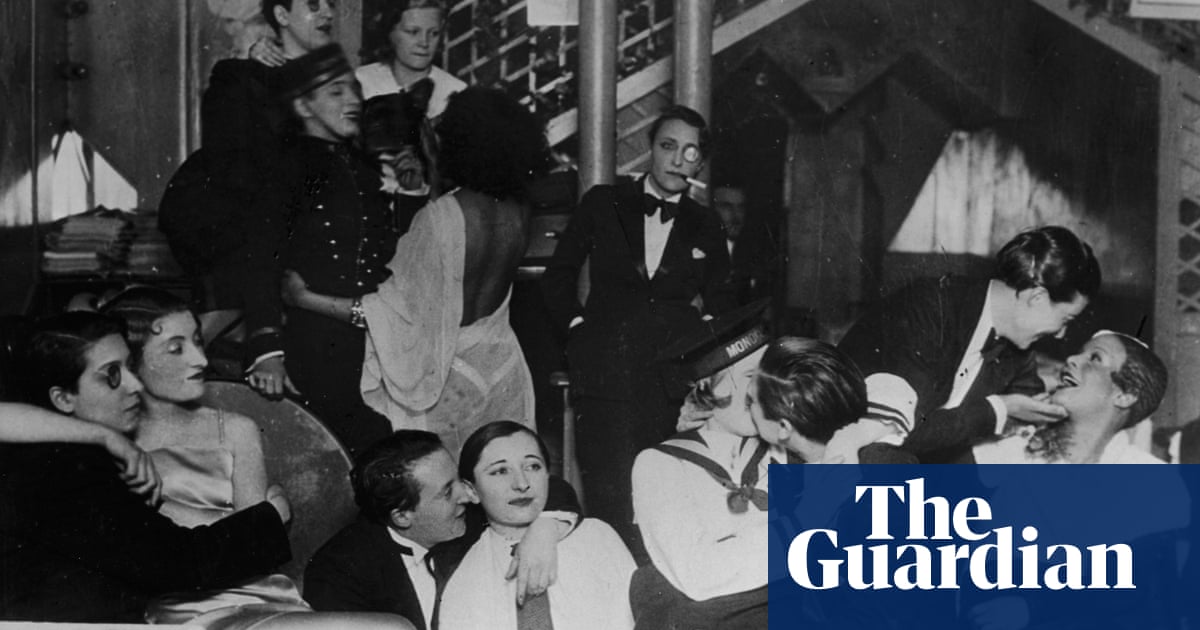âWhen it comes to lesbians, clothes can really shape our place in the world,â says the fashion historian Eleanor Medhurst. âThey can let us be recognised by others in our community, or allow us to be hidden to the world at large.â
She takes the example of Christina, Queen of Sweden in the 17th century. While Christinaâs sexuality remains ambiguous, there is evidence she felt romantically towards women. Her clothing choices still speak to some lesbians today, Medhurst included, in the way that she toyed with stereotypes. âShe would play with gender through her self-presentation,â says Medhurst. âShe was often, throughout her life, mixing masculine and feminine clothes,â wearing menâs shoes, shirts and vests, as well as elaborate womenâs gowns and skirts.
Christina is just one of the subjects of Medhurstâs new book, Unsuitable: A History of Lesbian Fashion, which charts the diversity of clothing worn by women-loving women throughout history â their personal lives often hidden or their romantic relationships dismissed as friendships.
The women of the 1920s Parisian lesbian bar Le Monocle, whose styles ranged from tuxedos and ties to dresses and bobs set in finger waves are included. So is the drag king Stormé DeLarverie, who some say threw the first punch at the 1969 Stonewall uprising, and who would often wear tailored suits for performances or leather jackets in her other job as a bouncer. Medway delves into the styles of those who were lesbians or who may have identified with todayâs LGBTQ+ community, even if such labels didnât exist in their time.
It comes at a time when âlesbian fashionâ is bursting back into the mainstream. That fashion is as diverse as the lesbian community itself, but one definition might be clothing stereotypically worn or inspired by lesbians, which has often broken gendered expectations. In May, Kristen Stewart, who Medhurst describes as âa figurehead of 2020s lesbian-chicâ, delivered tank tops and sports bras in the hit lesbian thriller Love Lies Bleeding. In February, the New York Times celebrated the fashion label Kallmeyer, popular for its suits and waistcoats, as serving âlesbian chic, for allâ. Lesbian and queer fashion is visible from musicians Muna to Young MA and Reneé Rapp through to the BBCâs recent lesbian dating series I Kissed A Girl, which showcased statement boots, rings and snapbacks. The queer satirical film Bottoms, starring Ayo Edebiri, serves up stereotypical lesbian staples â corduroy trousers, dungarees and flannel shirts.
âLesbians are having a bit of a cultural moment,â says Medhurst, who has herself played a part. Having set up her blog Dressing Dykes during the pandemic, her TikTok account now has more than 100,000 followers.
But the history of âlesbian fashionâ is a complicated one. Wider society hasnât always considered clothing worn by lesbians as cool. Often, the way lesbians dress, particularly those wearing masculine clothing, has been seen as unfashionable, a point of intrigue or just plain ugly. In Medhurstâs book, she explores the 19th-century life of Anne Lister, dubbed âthe first modern lesbianâ, who wore gentlemenâs braces and black â at the time deemed a masculine colour â alongside bonnets and ribbons. Listerâs appearance wasnât liked by all her contemporaries: she was referred to pejoratively as âGentleman Jackâ â the nickname later used as the title for the BBC drama about her life.
after newsletter promotion
âLesbian fashion has gone in and out of mainstream fashion,â says Medhurst. In the late 19th century, male impersonators flourished in Victorian Britain and the US; not all were lesbians, but some possibly were. The drag king Annie Hindle had at least one unofficial marriage to another woman. In the 1920s, the lesbian couple Dorothy Todd and Madge Garland brought queer influences to British Vogue as the editor and fashion editor respectively; Virginia Woolf and Vita Sackville-West were among its contributors.
In the spring of 1993, the term âlesbian chicâ was splashed across the front cover of New York magazine, accompanied by a portrait of a sauve-looking kd lang, the Canadian musician and lesbian icon. Later that year, lang would pose in a three-piece suit on the front cover of Vanity Fair, reclining in a barberâs chair with the supermodel Cindy Crawford, wearing a swimsuit, pretending to shave her face.
However, the commodification of the lesbian look has not always come with the approval of lesbians themselves. In a blogpost on the concept of âlesbian chicâ, from lang to the TV drama The L Word, Medhurst cites lesbian critics who hit back at the sanitised depictions of lesbians in the 90s mainstream, which eschewed the full diversity of the lesbian aesthetic in favour of more airbrushed versions: models were generally white, slim and without body hair.
The whole concept of âlesbian chic feels frustrating for some lesbiansâ, says Medhurst, âbecause the clothes that they have been wearing have been seen as being unfashionable, and anti-fashion, and ugly. Now, suddenly, theyâre great and theyâre fine. So thereâs that element of it being like: âOh, but you hated these clothes!ââ Some remain critical of seeing stereotypical accessories â from carabiners to practical footwear â in the mainstream, while others embrace it.
But today at least there is greater, though still not complete, diversity when it comes to what it means to look like or be a lesbian, from butch through to high-femme, with the lesbian cultural scene also encompassing trans, bisexual and queer identities.
While Medhurst understands the frustrations of some lesbians, she also thinks there are benefits. âA lot of the stereotypes of lesbian style are things that are practical or comfortable ⦠I think thereâs definitely a huge positive element in those being mainstream fashion for women, because women historically have been encouraged to not wear comfortable or practical clothes.â
Ultimately, lesbian fashion offers âways that we can play with gender roles, categories of sexuality, ways that we are or are not allowed to be,â says Medhurst. For some lesbians, and the LGBTQ+ community more broadly, clothing is a vital form of self-expression; itâs a means of signalling identity to the world, whether discreetly or overtly. As Medhurst concludes: âFashion is often thought of as being quite a frivolous thing. But itâs actually incredibly important, personally and politically.â
Unsuitable: A History of Lesbian Fashion, by Eleanor Medhurst is out now (Hurst Publishers)









